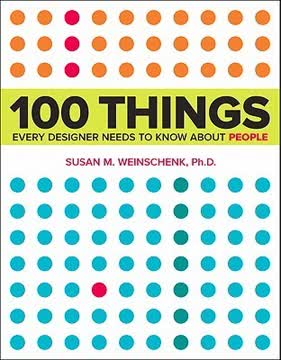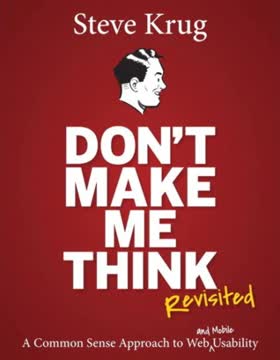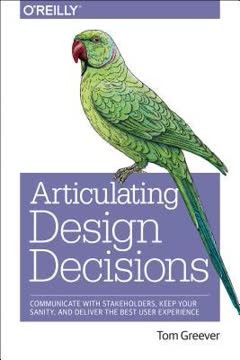Key Takeaways
1. Design is storytelling: Create narratives that engage users emotionally and functionally
"Design uses form, color, materials, language, and systems thinking to transform the meaning of everything from transit signs and web apps to shampoo bottles and emergency shelters."
Beyond problem-solving. Design is not just about solving problems, but about creating meaningful narratives that resonate with users. It involves crafting experiences that unfold over time, engaging users emotionally and intellectually.
Multifaceted approach. Designers use various elements to tell stories:
- Visual elements: Color, form, typography
- Interaction design: User flows, interface elements
- Language: Naming, descriptions, instructions
- Materials: Textures, physical properties
- Systems thinking: How all elements work together
By considering these aspects, designers can create products and experiences that not only function well but also connect with users on a deeper level, inspiring action, emotion, and loyalty.
2. Narrative arc: Structure experiences with rising action, climax, and resolution
"A well-made sentence moves ideas from the head of a writer to the head of a reader."
Applying storytelling structure. Just as stories have a beginning, middle, and end, so too should user experiences. This structure helps create tension, interest, and satisfaction.
Elements of a narrative arc in design:
- Exposition: Introducing the product or service
- Rising action: Building engagement and interest
- Climax: Peak moment of interaction or realization
- Falling action: Resolving user needs or questions
- Resolution: Completing the experience, leaving a lasting impression
By consciously structuring experiences with these elements, designers can create more engaging and memorable interactions. This approach works for everything from unboxing a new product to navigating a website or using an app.
3. Hero's journey: Guide users through transformative product interactions
"Stories travel from person to person and place to place. A well-made sentence moves ideas from the head of a writer to the head of a reader."
User as hero. In this model, the user is the protagonist of their own story, with the product or service acting as a guide or tool for transformation.
Stages of the hero's journey in design:
- Call to action: Marketing or initial product encounter
- Threshold: First use or onboarding
- Challenges: Learning to use the product effectively
- Transformation: Mastering the product and achieving goals
- Return: Becoming an advocate or repeat customer
By framing the user experience as a heroic journey, designers can create more meaningful and empowering interactions. This approach helps users feel a sense of accomplishment and personal growth through their use of a product or service.
4. Scenario planning: Anticipate future trends and user needs to inform design
"Scenario planning is a tool for telling stories about the future."
Future-proofing design. By imagining potential future scenarios, designers can create more adaptable and resilient products and services.
Steps in scenario planning:
- Identify key trends and uncertainties
- Develop multiple plausible future scenarios
- Explore implications for users and products
- Design flexible solutions that work across scenarios
- Continuously monitor and adjust as the future unfolds
Scenario planning helps designers think beyond current constraints and anticipate evolving user needs. This approach can lead to more innovative and long-lasting design solutions that remain relevant as the world changes.
5. Emotional journey: Map and design for users' changing feelings over time
"Emotions are adaptations that aid the survival of a species. Fear compels us to flee from danger, while love moves us to protect our young."
Emotion-driven design. Understanding and designing for users' emotional states throughout their interaction with a product or service can lead to more satisfying and effective experiences.
Components of an emotional journey map:
- Touchpoints: Key moments of interaction
- Emotions: Positive and negative feelings at each point
- Intensity: Strength of emotional response
- Actions: What users do in response to emotions
- Opportunities: Areas for improvement or enhancement
By mapping out the emotional journey, designers can identify pain points, moments of delight, and opportunities to create stronger emotional connections with users. This approach helps create more human-centered and empathetic designs.
6. Co-creation: Involve users in the design process to build empathy and innovation
"Designers use co-creation activities to involve users in order to understand the context of a project and learn how new solutions could improve people's lives."
Collaborative design. By involving users directly in the design process, designers can gain deeper insights and create more effective solutions.
Co-creation methods:
- Workshops: Bringing users and designers together to brainstorm
- Prototype testing: Getting user feedback on early-stage designs
- Cultural probes: Giving users tools to document their experiences
- Participatory design: Users as active members of the design team
- Crowdsourcing: Gathering ideas and feedback from large groups
Co-creation helps bridge the gap between designers' assumptions and users' real needs and desires. It can lead to more innovative solutions and greater user satisfaction by ensuring that designs truly meet user needs and expectations.
7. Multisensory design: Engage all senses to create memorable, impactful experiences
"Reaching beyond design's traditional focus on vision, multisensory design incorporates the full range of bodily experience."
Holistic sensory engagement. By considering all senses in the design process, creators can craft richer, more immersive experiences that resonate more deeply with users.
Senses to consider in design:
- Vision: Color, shape, typography, imagery
- Sound: Music, ambient noise, interaction sounds
- Touch: Textures, temperatures, haptic feedback
- Smell: Scents, fragrances (or lack thereof)
- Taste: Flavors, mouthfeel (for food/beverage products)
Multisensory design can enhance user engagement, improve memory and recall of experiences, and create stronger emotional connections. This approach is particularly powerful in retail environments, product design, and interactive digital experiences.
8. Gestalt principles: Use visual grouping to guide perception and understanding
"According to the Gestalt principles of perception, the brain converts a flood of data about color, tone, shape, movement, and orientation into distinct objects."
Visual organization. Understanding how the human brain naturally groups and organizes visual information can help designers create more intuitive and easily understood interfaces and layouts.
Key Gestalt principles:
- Proximity: Objects close together are perceived as a group
- Similarity: Similar objects are seen as related
- Closure: The mind fills in gaps to complete shapes
- Continuity: The eye follows smooth paths or lines
- Figure/Ground: Objects are perceived as either foreground or background
By applying these principles, designers can create visual hierarchies, guide user attention, and communicate relationships between elements more effectively. This leads to more intuitive and user-friendly designs across various mediums.
9. Behavioral economics: Apply psychology insights to nudge user decisions
"Humans constantly make decisions based on impulses, gut feelings, or force of habit. Such decisions evade rational analysis."
Psychological influences. Understanding the cognitive biases and heuristics that affect decision-making can help designers create more effective and persuasive interfaces and experiences.
Key behavioral economics concepts in design:
- Default bias: People tend to stick with pre-selected options
- Scarcity effect: Limited availability increases perceived value
- Social proof: People follow the actions of others
- Anchoring: Initial information influences subsequent decisions
- Loss aversion: People prefer avoiding losses to acquiring gains
By carefully applying these principles, designers can guide users towards desired actions or behaviors. However, it's crucial to use these techniques ethically, always prioritizing user benefit over manipulation.
10. Affordances: Design intuitive interactions through form and function cues
"An object that triggers an action is called an affordance."
Intuitive design. By incorporating visual and physical cues that suggest how an object should be used, designers can create more user-friendly and self-explanatory products and interfaces.
Types of affordances:
- Physical: Shape suggests how to hold or manipulate an object
- Visual: Graphics or colors indicate interactive elements
- Cognitive: Design patterns that users recognize from past experiences
- Functional: Features that clearly communicate their purpose
- Sensory: Textures or sounds that guide interaction
Well-designed affordances reduce the learning curve for new users and make interactions more efficient and satisfying. This principle applies to both physical product design and digital interface design, helping users intuitively understand how to interact with a system or object.
Last updated:
FAQ
What's "Design Is Storytelling" about?
- Narrative Techniques in Design: The book explores how designers can use storytelling techniques to create engaging graphics, products, services, and experiences.
- Psychology of Perception: It examines the psychology of visual perception from a narrative perspective, helping designers understand how to lead users on dynamic journeys.
- Practical Tools and Concepts: Ellen Lupton provides a toolkit of methods and concepts to amplify the narrative power of design work.
- Educational Resource: The book includes prompts for students and teachers, making it a valuable resource for design education.
Why should I read "Design Is Storytelling"?
- Enhance Design Skills: The book offers practical insights into using storytelling to enhance the effectiveness and engagement of design projects.
- Understand User Experience: It provides a deeper understanding of how narrative elements can influence user experience and perception.
- Inspiration for Creativity: The book is filled with examples and illustrations that can inspire creative thinking and innovation in design.
- Educational Value: With its structured approach, it serves as a useful guide for both novice and experienced designers looking to improve their craft.
What are the key takeaways of "Design Is Storytelling"?
- Storytelling in Design: Design is not just about aesthetics; it's about creating a narrative that engages users emotionally and intellectually.
- User-Centered Approach: Understanding the user's journey and emotional experience is crucial for effective design.
- Multisensory Engagement: Good design engages multiple senses, not just sight, to create a more immersive experience.
- Practical Application: The book provides actionable tools and methods that designers can apply to their projects immediately.
How does Ellen Lupton define storytelling in design?
- Narrative Arc: Lupton emphasizes the importance of a narrative arc, which includes a beginning, middle, and end, to guide the user's experience.
- Emotional Engagement: Storytelling in design should evoke emotions and create memorable experiences for users.
- Action and Interaction: Design should prompt users to take action and interact with the product or service in meaningful ways.
- Cultural and Contextual Relevance: Effective storytelling considers the cultural and contextual background of the target audience.
What is the "Hero's Journey" in design according to Ellen Lupton?
- Classic Narrative Structure: The Hero's Journey is a narrative pattern that involves a hero who goes on an adventure, faces a crisis, and returns transformed.
- Application in Design: Designers can use this structure to map out user experiences, ensuring that they are engaging and transformative.
- Emotional Peaks and Valleys: The journey includes emotional highs and lows, which can be mirrored in the user's interaction with a design.
- Guiding User Experience: By applying the Hero's Journey, designers can create a more compelling and cohesive user experience.
What role does emotion play in design as discussed in "Design Is Storytelling"?
- Emotional Intelligence: Designers need to understand and harness emotions to create designs that resonate with users.
- User's Emotional Journey: Mapping out the emotional journey of users helps in anticipating friction points and offering rewards.
- Empathy in Design: Building empathy with users is crucial for creating solutions that enhance their lives and meet their needs.
- Temporal Nature of Emotion: Emotions change over time, and design should accommodate these shifts to maintain user engagement.
How does "Design Is Storytelling" address the concept of multisensory design?
- Beyond Visuals: Multisensory design incorporates all senses, not just sight, to create a richer user experience.
- Flavor and Texture: The book discusses how elements like flavor and texture can influence perception and engagement.
- Empathic Design: Designers are encouraged to consider how people with different abilities experience their designs.
- Practical Examples: The book provides examples of how multisensory elements can be integrated into everyday products and services.
What is the significance of the "Experience Economy" in design?
- Shift from Products to Experiences: The Experience Economy emphasizes creating memorable events rather than just selling products.
- Theatrical Engagement: Design is seen as a form of theater, where users are engaged in a narrative performance.
- User Participation: Modern experiences are participatory, with users playing active roles in shaping the narrative.
- Economic Value: Experiences add value to products, making them more desirable and often more expensive.
How does Ellen Lupton suggest using color in design storytelling?
- Emotional Triggers: Color is a powerful tool for evoking emotions and setting the mood in design.
- Cultural Significance: Different colors have different meanings across cultures, which designers must consider.
- Color Scripts: Similar to film, color scripts can be used to map out the emotional journey of a design project.
- Practical Application: The book provides guidance on using color to enhance the narrative and emotional impact of a design.
What are some practical tools and methods from "Design Is Storytelling"?
- Narrative Arc and Storyboards: Tools like narrative arcs and storyboards help designers plan and visualize the user journey.
- Emotional Journey Maps: These maps help designers understand and anticipate the emotional highs and lows of user interactions.
- Scenario Planning: This method allows designers to explore different future scenarios and their potential impact on design.
- Co-Creation and Empathy: Engaging users in the design process through co-creation activities builds empathy and leads to better solutions.
What are the best quotes from "Design Is Storytelling" and what do they mean?
- "Design is an art of thinking ahead and predicting possible futures." This quote emphasizes the proactive nature of design, where anticipating user needs and future trends is crucial.
- "A great story does more than represent emotion from a distance. It makes us feel an emotional charge." This highlights the importance of creating designs that evoke genuine emotions rather than just depicting them.
- "Good design connects people through shared experience." This underscores the role of design in fostering connections and building community through common narratives.
- "Designers today produce more than logos and cereal boxes; they create situations that stimulate the mind and body over time." This reflects the expanded role of designers in creating immersive and engaging experiences.
How can "Design Is Storytelling" be used in a classroom setting?
- Educational Prompts: The book includes prompts and exercises that can be used to teach design students about storytelling techniques.
- Project-Based Learning: Students can apply the book's concepts to real-world projects, enhancing their practical skills.
- Discussion and Analysis: The book's content can serve as a basis for class discussions on the role of narrative in design.
- Resource for Teachers: It provides a structured approach to teaching design, making it a valuable resource for educators.
Review Summary
Design Is Storytelling receives generally positive reviews, with an average rating of 3.97 out of 5. Readers appreciate its visual appeal, practical examples, and accessible introduction to storytelling in design. Many find it useful for beginners or those seeking creative inspiration. Some criticize its lack of depth for experienced designers. The book's structure, covering action, emotion, and sensation, is praised for its clarity. Readers highlight its value in providing vocabulary for communicating design concepts and its potential as a reference tool for various design fields.
Similar Books









Download PDF
Download EPUB
.epub digital book format is ideal for reading ebooks on phones, tablets, and e-readers.






